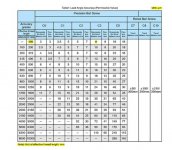I've recently converted a mill to CNC . The X axis is a THK C3 ground ball screw. I got it used via Ebay from Korea – in great shape and looks like new - with ball-nut and bearings. It is a metric screw with 2.5 mm pitch and marked as such, together with the THK logo, on the nut assembly. The ball screw assembly was installed very accurately with the table parts bored together in the same setting and the nut housing secured with taper pins and screws. The total backlash of the table is under a couple of microns (little less than one tenth).
When advancing the table it moves further than it supposed. 10 turns should move it 25mm, but it actually goes 25.03 - 25.04. 20 turns moves it about 50.08 and so on. This is true in both directions. The most intriguing is that the error is not consistent, but always on the plus side. And any slip or backlash would result in a shorter travel.
Initially I though it is a problem with the stepper or the software, but it is the same when I've installed a hand-wheel with a dial directly on the screw end.
Any thoughts on this?
Thanks,
Bill.
When advancing the table it moves further than it supposed. 10 turns should move it 25mm, but it actually goes 25.03 - 25.04. 20 turns moves it about 50.08 and so on. This is true in both directions. The most intriguing is that the error is not consistent, but always on the plus side. And any slip or backlash would result in a shorter travel.
Initially I though it is a problem with the stepper or the software, but it is the same when I've installed a hand-wheel with a dial directly on the screw end.
Any thoughts on this?
Thanks,
Bill.




 ) just last night I though about this and have checked the travel with the indicator mounted at the height of the lead-screw centre. The error is indeed a few microns smaller but still almost 10 times the spec. I shall have the final verdict once I remove the screw and nut and check those on the bench but it does look that the pitch is for some reason more than the indicated 2.5mm.
) just last night I though about this and have checked the travel with the indicator mounted at the height of the lead-screw centre. The error is indeed a few microns smaller but still almost 10 times the spec. I shall have the final verdict once I remove the screw and nut and check those on the bench but it does look that the pitch is for some reason more than the indicated 2.5mm.